Network Design for Acme Organization
VerifiedAdded on 2020/05/11
|12
|1726
|88
AI Summary
The assignment presents a detailed network design plan for Acme organization, focusing on implementing an IPv6 address policy. It includes aspects like VLAN segmentation, inter-VLAN routing, router configuration with various routing protocols, and securing the network by restricting physical access to core components. The document also discusses best practices for device positioning and software updates to ensure optimal network performance and security.
Contribute Materials
Your contribution can guide someone’s learning journey. Share your
documents today.

Running head: DESIGN NETWORK INFRASTRUCTURE
Design Network Infrastructure
Name of the Student
Name of the University
Author’s Note
Design Network Infrastructure
Name of the Student
Name of the University
Author’s Note
Secure Best Marks with AI Grader
Need help grading? Try our AI Grader for instant feedback on your assignments.

1
DESIGN NETWORK INFRASTRUCTURE
Table of Contents
1. Introduction......................................................................................................................2
2. Discussion on protocols...................................................................................................2
3. System testing and verification Strategy.........................................................................3
4. Network Design...............................................................................................................4
5. Identified Issues in the network.......................................................................................4
6. Implementation and functionality....................................................................................5
7. Show run configuration...............................................................................................7
8. Recommendations and conclusions.................................................................................9
Bibliography......................................................................................................................11
DESIGN NETWORK INFRASTRUCTURE
Table of Contents
1. Introduction......................................................................................................................2
2. Discussion on protocols...................................................................................................2
3. System testing and verification Strategy.........................................................................3
4. Network Design...............................................................................................................4
5. Identified Issues in the network.......................................................................................4
6. Implementation and functionality....................................................................................5
7. Show run configuration...............................................................................................7
8. Recommendations and conclusions.................................................................................9
Bibliography......................................................................................................................11
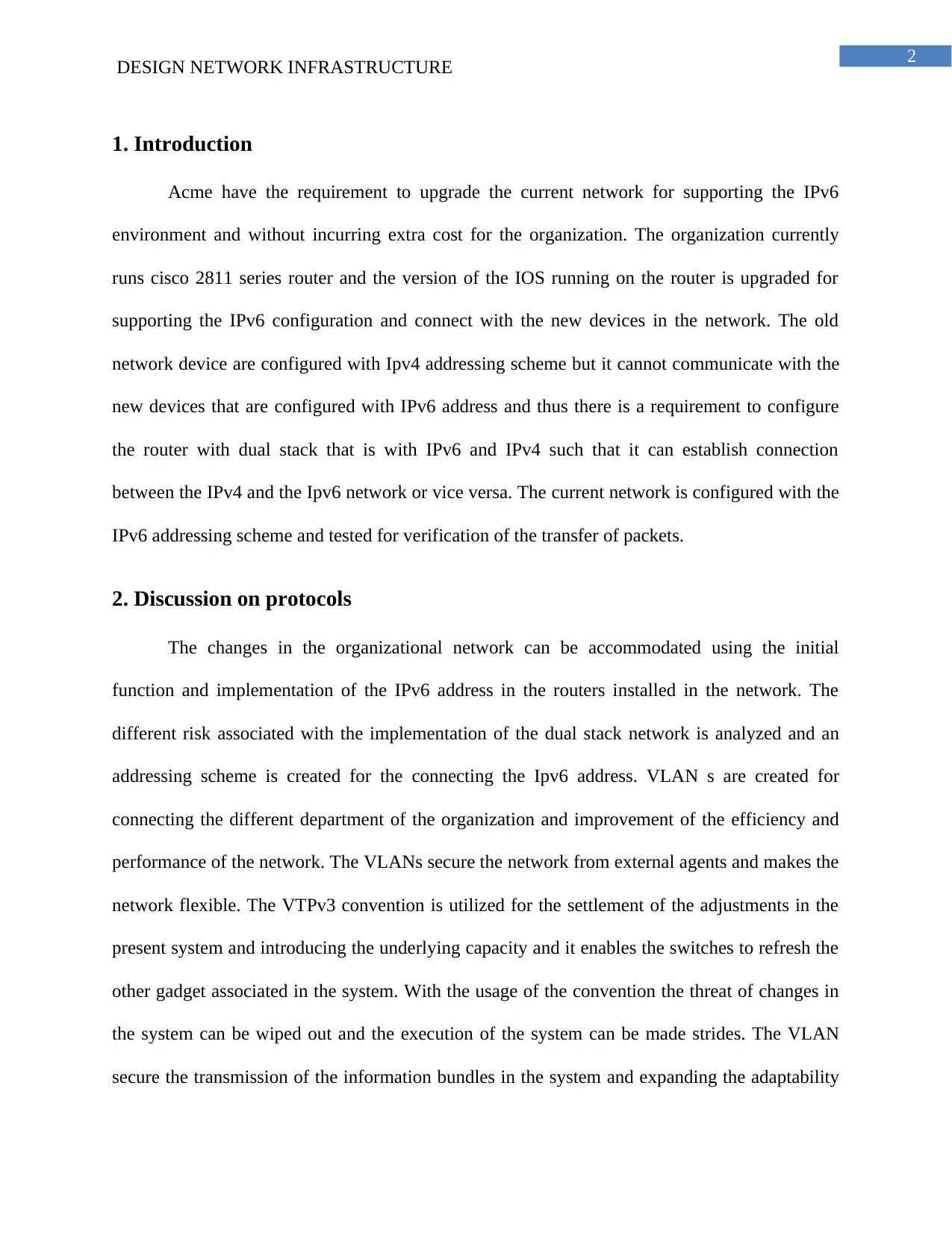
2
DESIGN NETWORK INFRASTRUCTURE
1. Introduction
Acme have the requirement to upgrade the current network for supporting the IPv6
environment and without incurring extra cost for the organization. The organization currently
runs cisco 2811 series router and the version of the IOS running on the router is upgraded for
supporting the IPv6 configuration and connect with the new devices in the network. The old
network device are configured with Ipv4 addressing scheme but it cannot communicate with the
new devices that are configured with IPv6 address and thus there is a requirement to configure
the router with dual stack that is with IPv6 and IPv4 such that it can establish connection
between the IPv4 and the Ipv6 network or vice versa. The current network is configured with the
IPv6 addressing scheme and tested for verification of the transfer of packets.
2. Discussion on protocols
The changes in the organizational network can be accommodated using the initial
function and implementation of the IPv6 address in the routers installed in the network. The
different risk associated with the implementation of the dual stack network is analyzed and an
addressing scheme is created for the connecting the Ipv6 address. VLAN s are created for
connecting the different department of the organization and improvement of the efficiency and
performance of the network. The VLANs secure the network from external agents and makes the
network flexible. The VTPv3 convention is utilized for the settlement of the adjustments in the
present system and introducing the underlying capacity and it enables the switches to refresh the
other gadget associated in the system. With the usage of the convention the threat of changes in
the system can be wiped out and the execution of the system can be made strides. The VLAN
secure the transmission of the information bundles in the system and expanding the adaptability
DESIGN NETWORK INFRASTRUCTURE
1. Introduction
Acme have the requirement to upgrade the current network for supporting the IPv6
environment and without incurring extra cost for the organization. The organization currently
runs cisco 2811 series router and the version of the IOS running on the router is upgraded for
supporting the IPv6 configuration and connect with the new devices in the network. The old
network device are configured with Ipv4 addressing scheme but it cannot communicate with the
new devices that are configured with IPv6 address and thus there is a requirement to configure
the router with dual stack that is with IPv6 and IPv4 such that it can establish connection
between the IPv4 and the Ipv6 network or vice versa. The current network is configured with the
IPv6 addressing scheme and tested for verification of the transfer of packets.
2. Discussion on protocols
The changes in the organizational network can be accommodated using the initial
function and implementation of the IPv6 address in the routers installed in the network. The
different risk associated with the implementation of the dual stack network is analyzed and an
addressing scheme is created for the connecting the Ipv6 address. VLAN s are created for
connecting the different department of the organization and improvement of the efficiency and
performance of the network. The VLANs secure the network from external agents and makes the
network flexible. The VTPv3 convention is utilized for the settlement of the adjustments in the
present system and introducing the underlying capacity and it enables the switches to refresh the
other gadget associated in the system. With the usage of the convention the threat of changes in
the system can be wiped out and the execution of the system can be made strides. The VLAN
secure the transmission of the information bundles in the system and expanding the adaptability
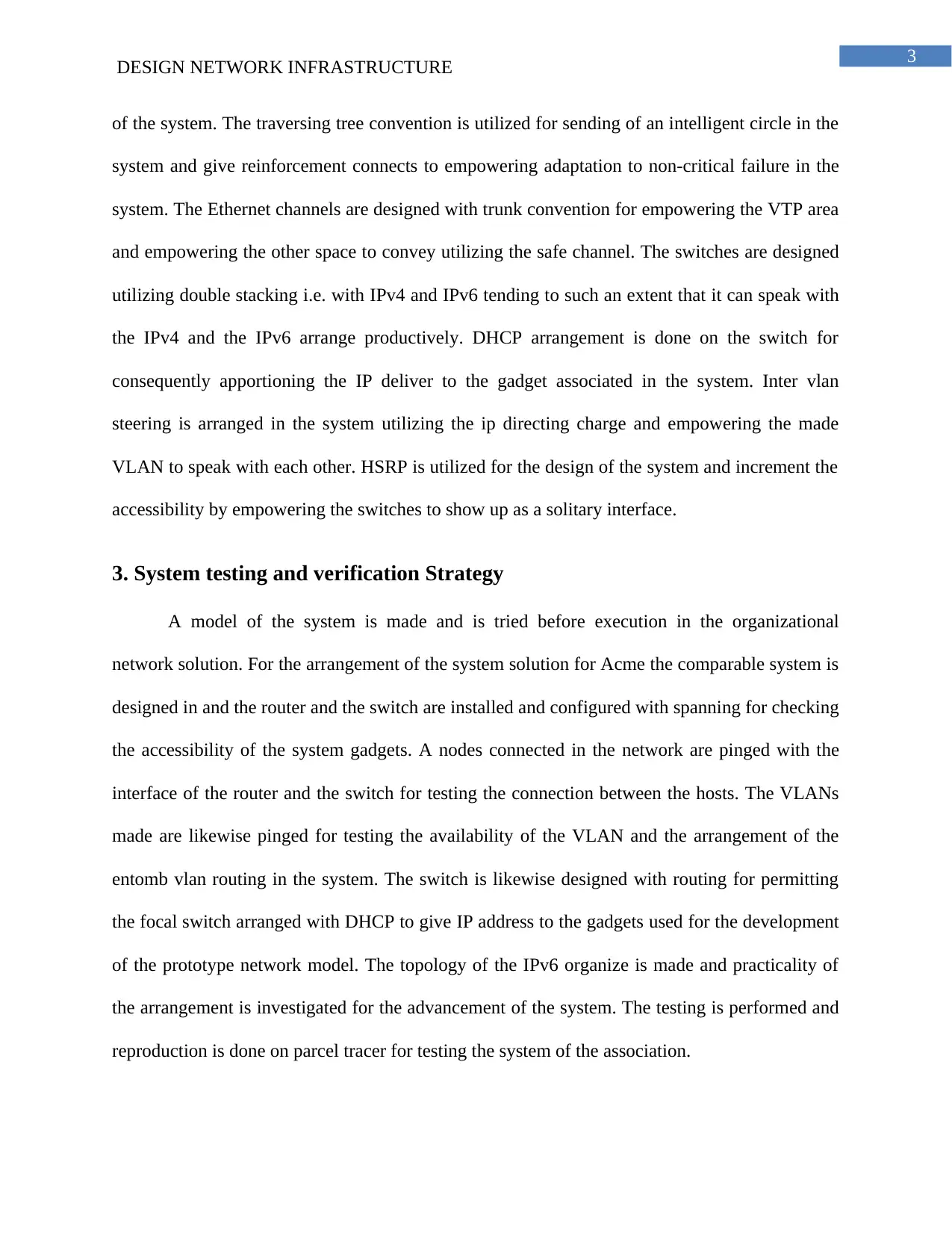
3
DESIGN NETWORK INFRASTRUCTURE
of the system. The traversing tree convention is utilized for sending of an intelligent circle in the
system and give reinforcement connects to empowering adaptation to non-critical failure in the
system. The Ethernet channels are designed with trunk convention for empowering the VTP area
and empowering the other space to convey utilizing the safe channel. The switches are designed
utilizing double stacking i.e. with IPv4 and IPv6 tending to such an extent that it can speak with
the IPv4 and the IPv6 arrange productively. DHCP arrangement is done on the switch for
consequently apportioning the IP deliver to the gadget associated in the system. Inter vlan
steering is arranged in the system utilizing the ip directing charge and empowering the made
VLAN to speak with each other. HSRP is utilized for the design of the system and increment the
accessibility by empowering the switches to show up as a solitary interface.
3. System testing and verification Strategy
A model of the system is made and is tried before execution in the organizational
network solution. For the arrangement of the system solution for Acme the comparable system is
designed in and the router and the switch are installed and configured with spanning for checking
the accessibility of the system gadgets. A nodes connected in the network are pinged with the
interface of the router and the switch for testing the connection between the hosts. The VLANs
made are likewise pinged for testing the availability of the VLAN and the arrangement of the
entomb vlan routing in the system. The switch is likewise designed with routing for permitting
the focal switch arranged with DHCP to give IP address to the gadgets used for the development
of the prototype network model. The topology of the IPv6 organize is made and practicality of
the arrangement is investigated for the advancement of the system. The testing is performed and
reproduction is done on parcel tracer for testing the system of the association.
DESIGN NETWORK INFRASTRUCTURE
of the system. The traversing tree convention is utilized for sending of an intelligent circle in the
system and give reinforcement connects to empowering adaptation to non-critical failure in the
system. The Ethernet channels are designed with trunk convention for empowering the VTP area
and empowering the other space to convey utilizing the safe channel. The switches are designed
utilizing double stacking i.e. with IPv4 and IPv6 tending to such an extent that it can speak with
the IPv4 and the IPv6 arrange productively. DHCP arrangement is done on the switch for
consequently apportioning the IP deliver to the gadget associated in the system. Inter vlan
steering is arranged in the system utilizing the ip directing charge and empowering the made
VLAN to speak with each other. HSRP is utilized for the design of the system and increment the
accessibility by empowering the switches to show up as a solitary interface.
3. System testing and verification Strategy
A model of the system is made and is tried before execution in the organizational
network solution. For the arrangement of the system solution for Acme the comparable system is
designed in and the router and the switch are installed and configured with spanning for checking
the accessibility of the system gadgets. A nodes connected in the network are pinged with the
interface of the router and the switch for testing the connection between the hosts. The VLANs
made are likewise pinged for testing the availability of the VLAN and the arrangement of the
entomb vlan routing in the system. The switch is likewise designed with routing for permitting
the focal switch arranged with DHCP to give IP address to the gadgets used for the development
of the prototype network model. The topology of the IPv6 organize is made and practicality of
the arrangement is investigated for the advancement of the system. The testing is performed and
reproduction is done on parcel tracer for testing the system of the association.
Secure Best Marks with AI Grader
Need help grading? Try our AI Grader for instant feedback on your assignments.
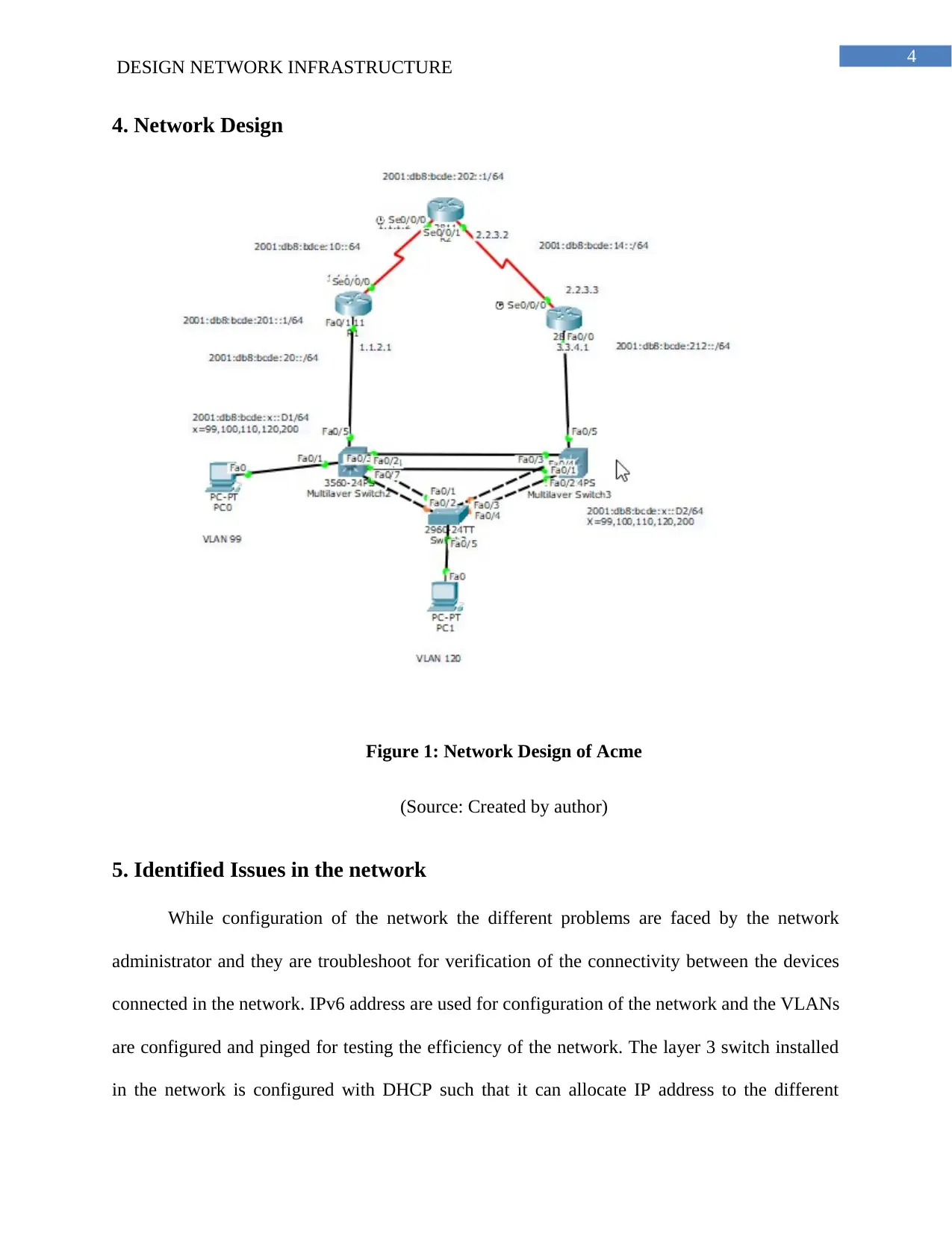
4
DESIGN NETWORK INFRASTRUCTURE
4. Network Design
Figure 1: Network Design of Acme
(Source: Created by author)
5. Identified Issues in the network
While configuration of the network the different problems are faced by the network
administrator and they are troubleshoot for verification of the connectivity between the devices
connected in the network. IPv6 address are used for configuration of the network and the VLANs
are configured and pinged for testing the efficiency of the network. The layer 3 switch installed
in the network is configured with DHCP such that it can allocate IP address to the different
DESIGN NETWORK INFRASTRUCTURE
4. Network Design
Figure 1: Network Design of Acme
(Source: Created by author)
5. Identified Issues in the network
While configuration of the network the different problems are faced by the network
administrator and they are troubleshoot for verification of the connectivity between the devices
connected in the network. IPv6 address are used for configuration of the network and the VLANs
are configured and pinged for testing the efficiency of the network. The layer 3 switch installed
in the network is configured with DHCP such that it can allocate IP address to the different
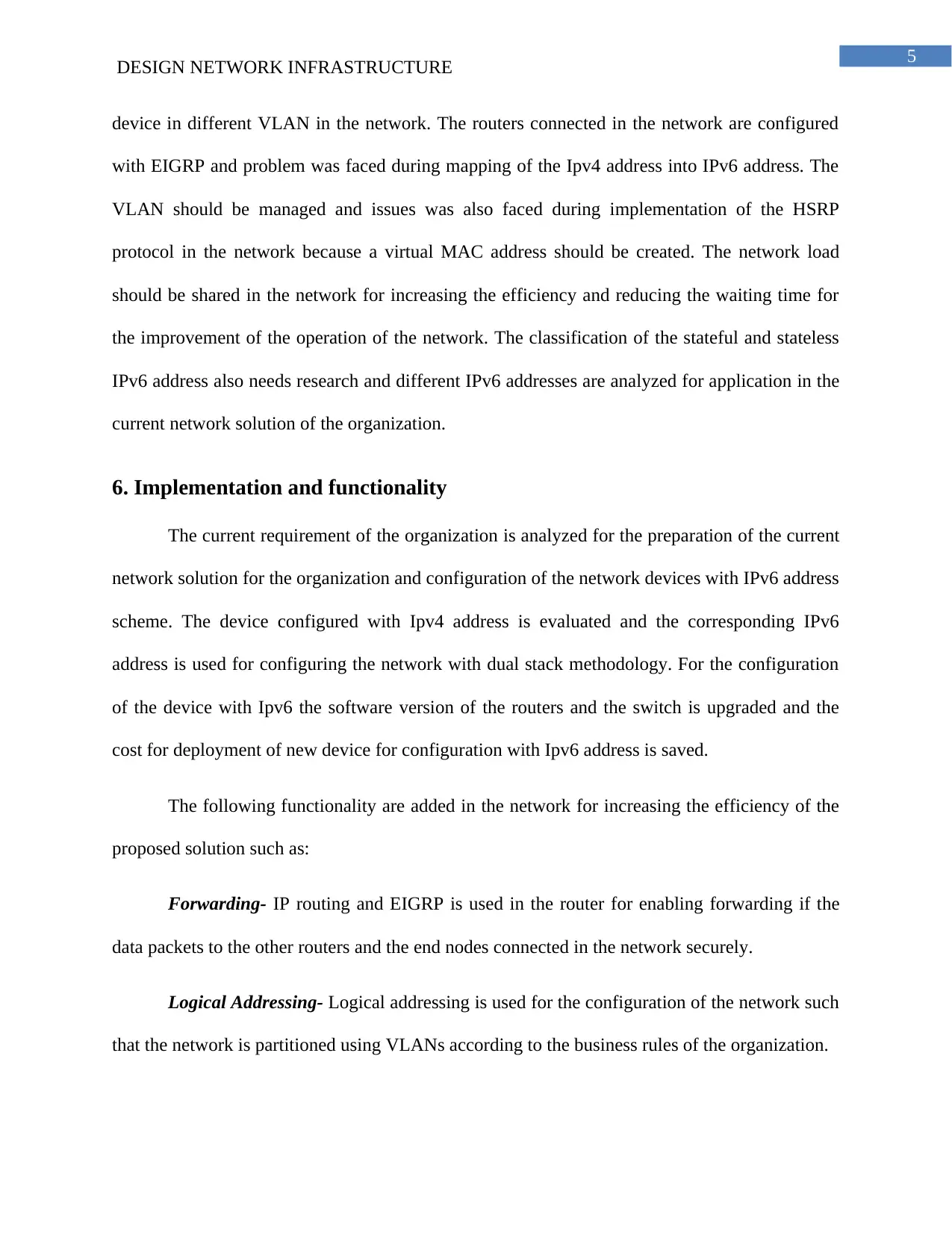
5
DESIGN NETWORK INFRASTRUCTURE
device in different VLAN in the network. The routers connected in the network are configured
with EIGRP and problem was faced during mapping of the Ipv4 address into IPv6 address. The
VLAN should be managed and issues was also faced during implementation of the HSRP
protocol in the network because a virtual MAC address should be created. The network load
should be shared in the network for increasing the efficiency and reducing the waiting time for
the improvement of the operation of the network. The classification of the stateful and stateless
IPv6 address also needs research and different IPv6 addresses are analyzed for application in the
current network solution of the organization.
6. Implementation and functionality
The current requirement of the organization is analyzed for the preparation of the current
network solution for the organization and configuration of the network devices with IPv6 address
scheme. The device configured with Ipv4 address is evaluated and the corresponding IPv6
address is used for configuring the network with dual stack methodology. For the configuration
of the device with Ipv6 the software version of the routers and the switch is upgraded and the
cost for deployment of new device for configuration with Ipv6 address is saved.
The following functionality are added in the network for increasing the efficiency of the
proposed solution such as:
Forwarding- IP routing and EIGRP is used in the router for enabling forwarding if the
data packets to the other routers and the end nodes connected in the network securely.
Logical Addressing- Logical addressing is used for the configuration of the network such
that the network is partitioned using VLANs according to the business rules of the organization.
DESIGN NETWORK INFRASTRUCTURE
device in different VLAN in the network. The routers connected in the network are configured
with EIGRP and problem was faced during mapping of the Ipv4 address into IPv6 address. The
VLAN should be managed and issues was also faced during implementation of the HSRP
protocol in the network because a virtual MAC address should be created. The network load
should be shared in the network for increasing the efficiency and reducing the waiting time for
the improvement of the operation of the network. The classification of the stateful and stateless
IPv6 address also needs research and different IPv6 addresses are analyzed for application in the
current network solution of the organization.
6. Implementation and functionality
The current requirement of the organization is analyzed for the preparation of the current
network solution for the organization and configuration of the network devices with IPv6 address
scheme. The device configured with Ipv4 address is evaluated and the corresponding IPv6
address is used for configuring the network with dual stack methodology. For the configuration
of the device with Ipv6 the software version of the routers and the switch is upgraded and the
cost for deployment of new device for configuration with Ipv6 address is saved.
The following functionality are added in the network for increasing the efficiency of the
proposed solution such as:
Forwarding- IP routing and EIGRP is used in the router for enabling forwarding if the
data packets to the other routers and the end nodes connected in the network securely.
Logical Addressing- Logical addressing is used for the configuration of the network such
that the network is partitioned using VLANs according to the business rules of the organization.
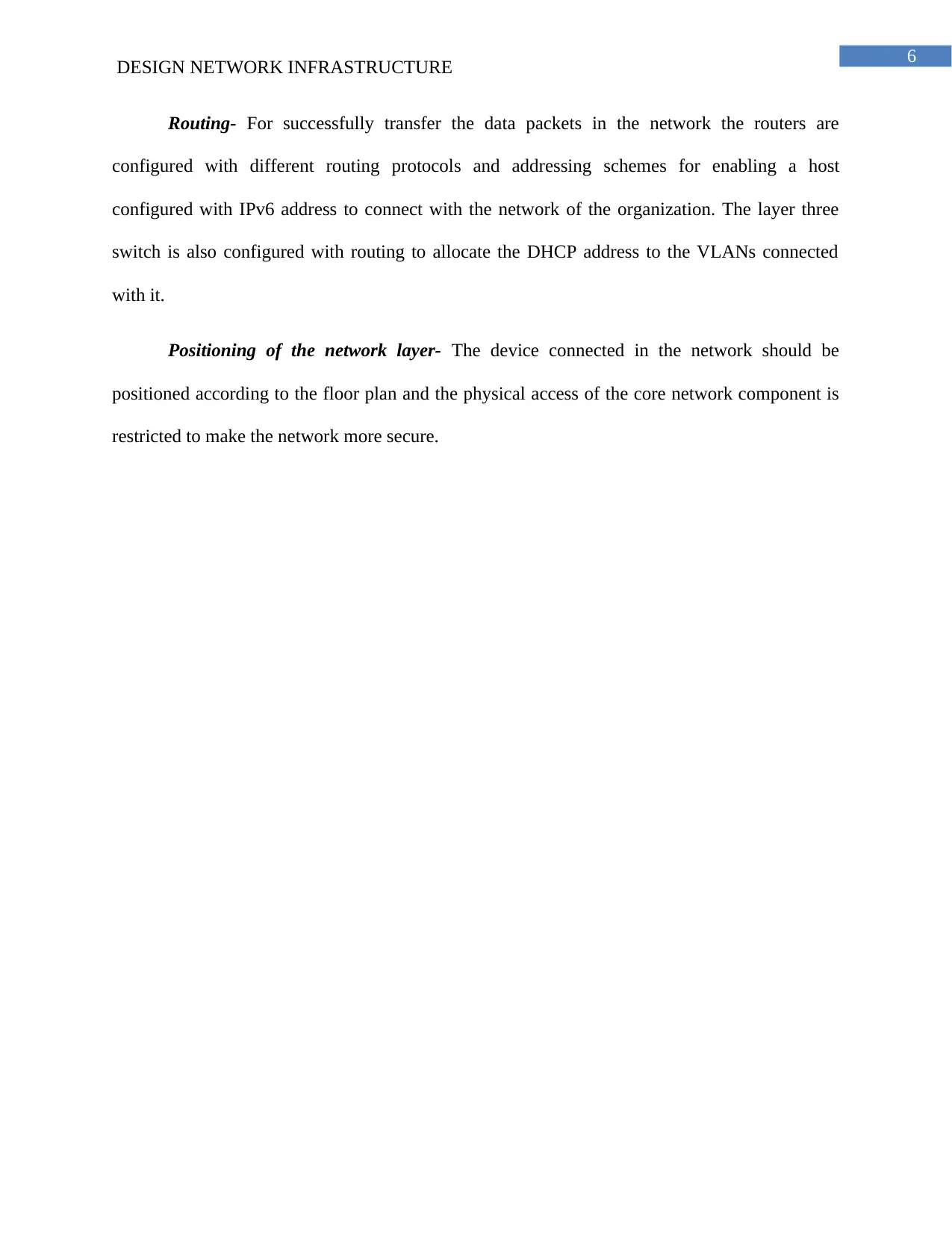
6
DESIGN NETWORK INFRASTRUCTURE
Routing- For successfully transfer the data packets in the network the routers are
configured with different routing protocols and addressing schemes for enabling a host
configured with IPv6 address to connect with the network of the organization. The layer three
switch is also configured with routing to allocate the DHCP address to the VLANs connected
with it.
Positioning of the network layer- The device connected in the network should be
positioned according to the floor plan and the physical access of the core network component is
restricted to make the network more secure.
DESIGN NETWORK INFRASTRUCTURE
Routing- For successfully transfer the data packets in the network the routers are
configured with different routing protocols and addressing schemes for enabling a host
configured with IPv6 address to connect with the network of the organization. The layer three
switch is also configured with routing to allocate the DHCP address to the VLANs connected
with it.
Positioning of the network layer- The device connected in the network should be
positioned according to the floor plan and the physical access of the core network component is
restricted to make the network more secure.
Paraphrase This Document
Need a fresh take? Get an instant paraphrase of this document with our AI Paraphraser
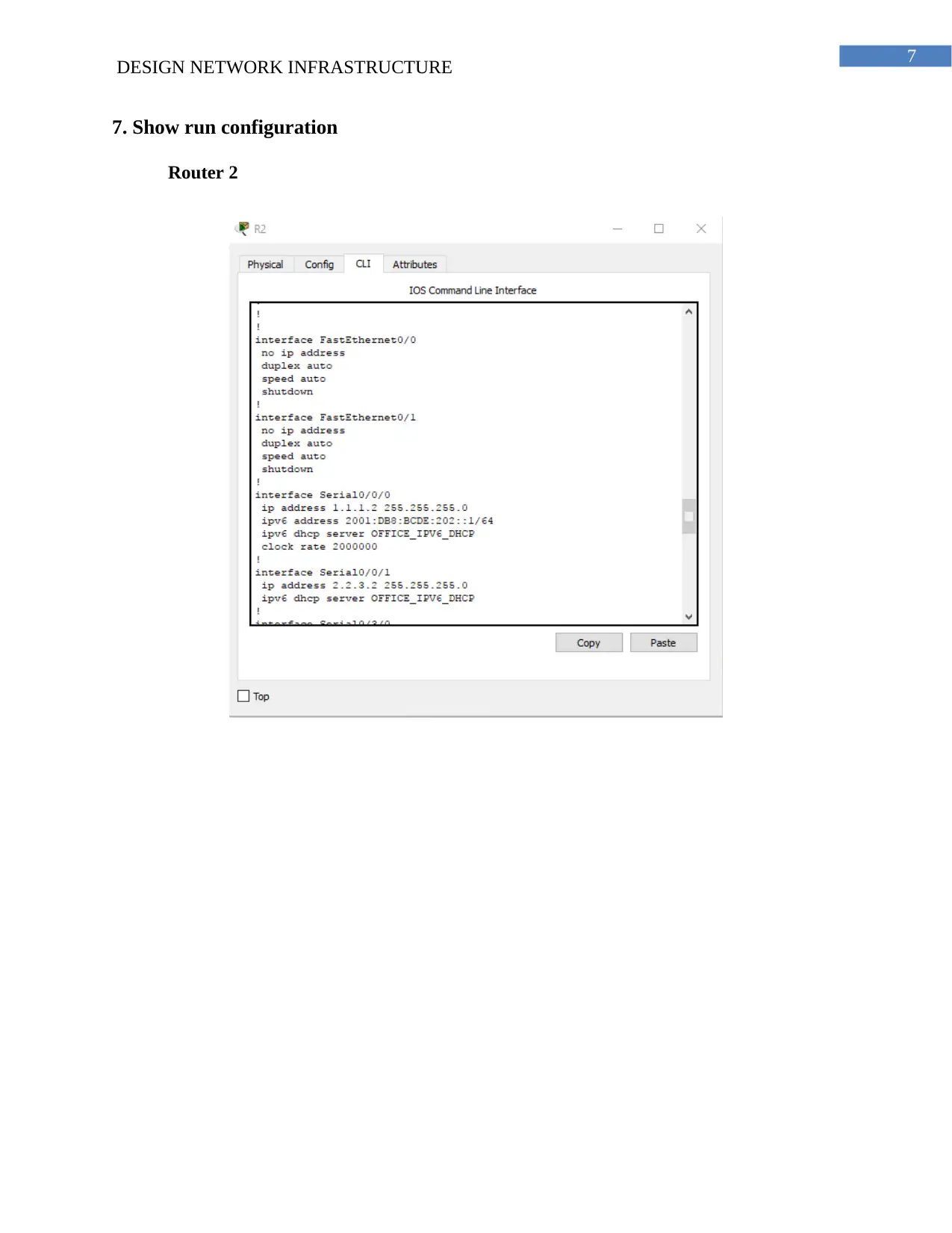
7
DESIGN NETWORK INFRASTRUCTURE
7. Show run configuration
Router 2
DESIGN NETWORK INFRASTRUCTURE
7. Show run configuration
Router 2
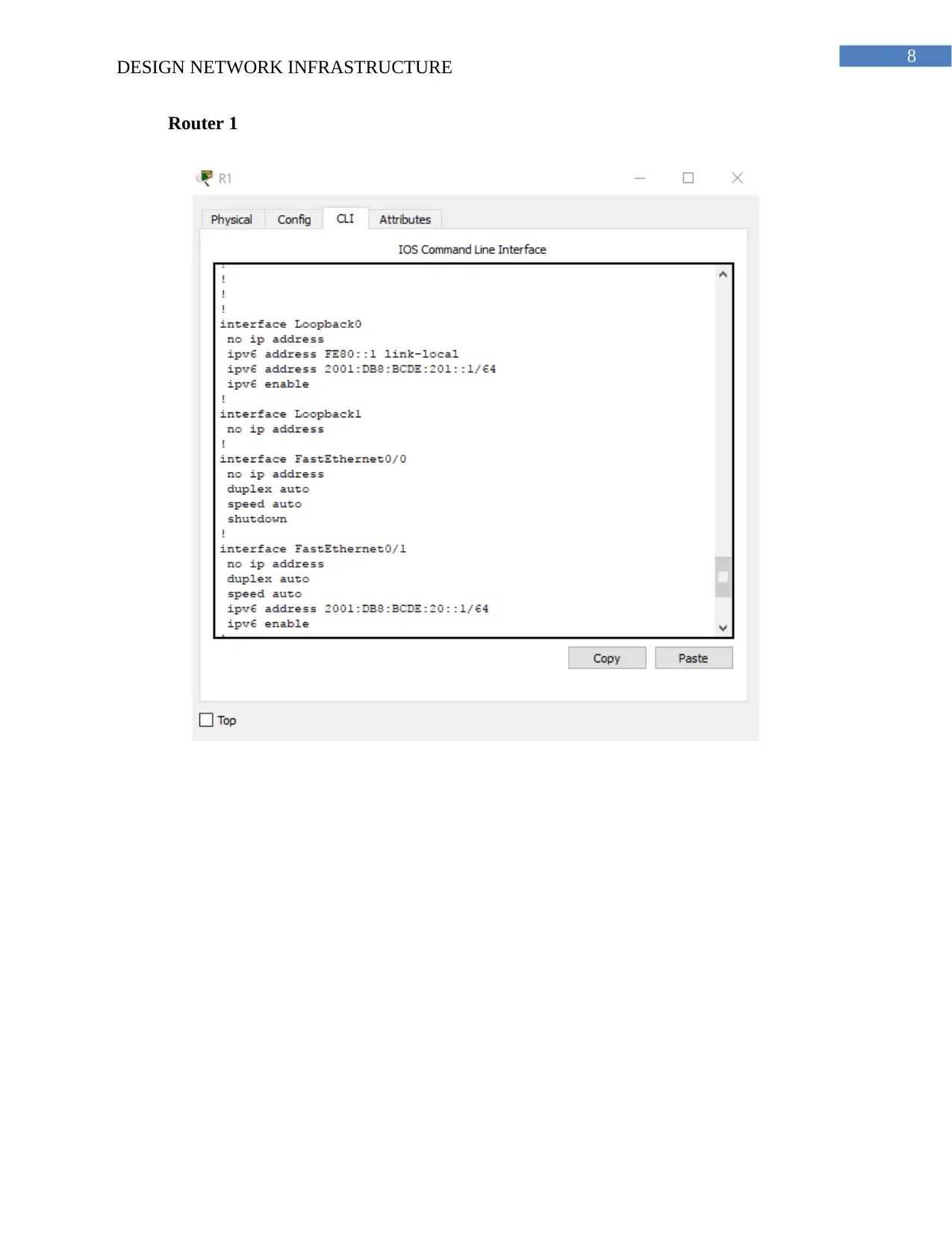
8
DESIGN NETWORK INFRASTRUCTURE
Router 1
DESIGN NETWORK INFRASTRUCTURE
Router 1
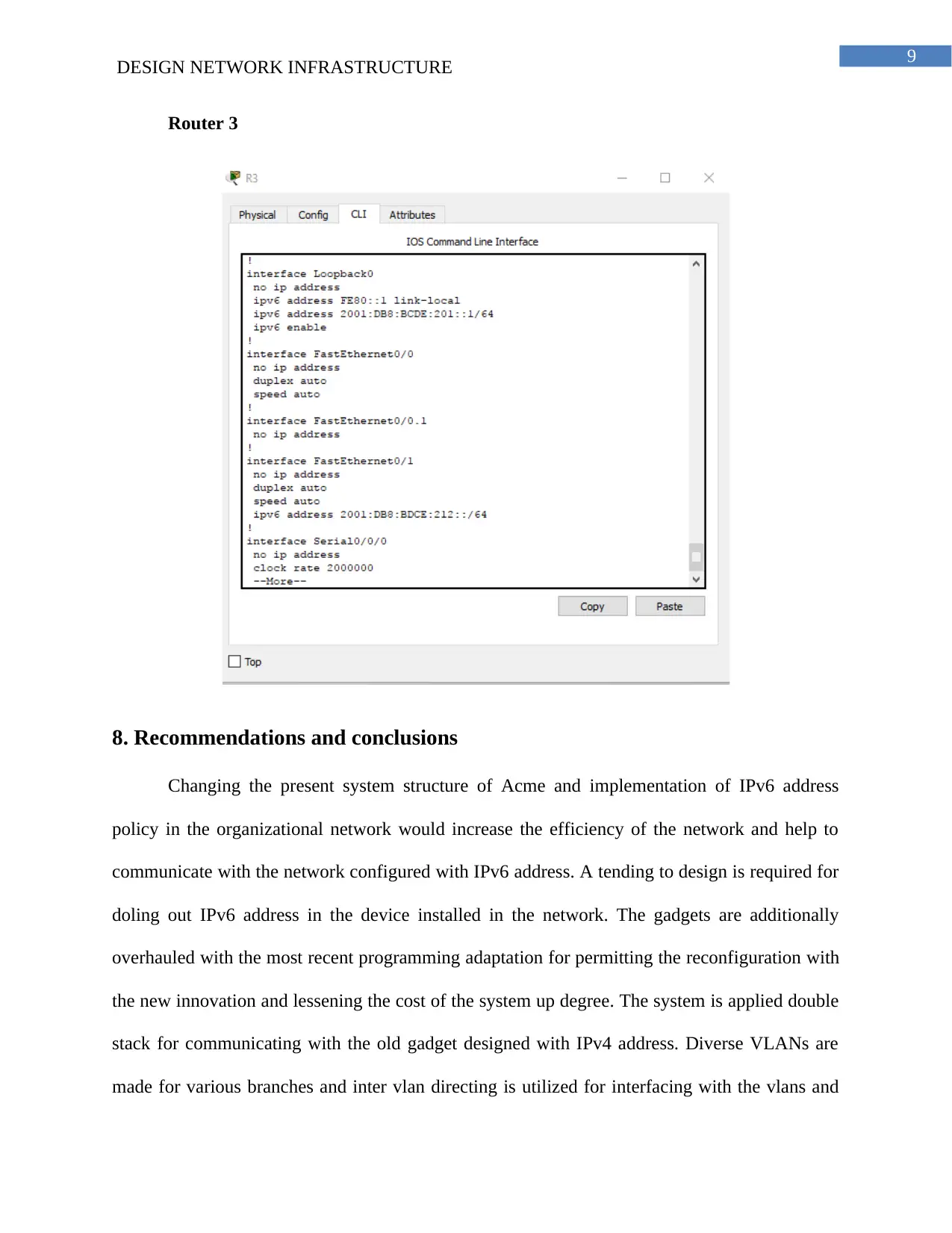
9
DESIGN NETWORK INFRASTRUCTURE
Router 3
8. Recommendations and conclusions
Changing the present system structure of Acme and implementation of IPv6 address
policy in the organizational network would increase the efficiency of the network and help to
communicate with the network configured with IPv6 address. A tending to design is required for
doling out IPv6 address in the device installed in the network. The gadgets are additionally
overhauled with the most recent programming adaptation for permitting the reconfiguration with
the new innovation and lessening the cost of the system up degree. The system is applied double
stack for communicating with the old gadget designed with IPv4 address. Diverse VLANs are
made for various branches and inter vlan directing is utilized for interfacing with the vlans and
DESIGN NETWORK INFRASTRUCTURE
Router 3
8. Recommendations and conclusions
Changing the present system structure of Acme and implementation of IPv6 address
policy in the organizational network would increase the efficiency of the network and help to
communicate with the network configured with IPv6 address. A tending to design is required for
doling out IPv6 address in the device installed in the network. The gadgets are additionally
overhauled with the most recent programming adaptation for permitting the reconfiguration with
the new innovation and lessening the cost of the system up degree. The system is applied double
stack for communicating with the old gadget designed with IPv4 address. Diverse VLANs are
made for various branches and inter vlan directing is utilized for interfacing with the vlans and
Secure Best Marks with AI Grader
Need help grading? Try our AI Grader for instant feedback on your assignments.

10
DESIGN NETWORK INFRASTRUCTURE
increment the proficiency and security of the system. The three switches associated in the system
are arranged with HSRP such a virtual switch is made and accessibility of the system is
expanded.
DESIGN NETWORK INFRASTRUCTURE
increment the proficiency and security of the system. The three switches associated in the system
are arranged with HSRP such a virtual switch is made and accessibility of the system is
expanded.
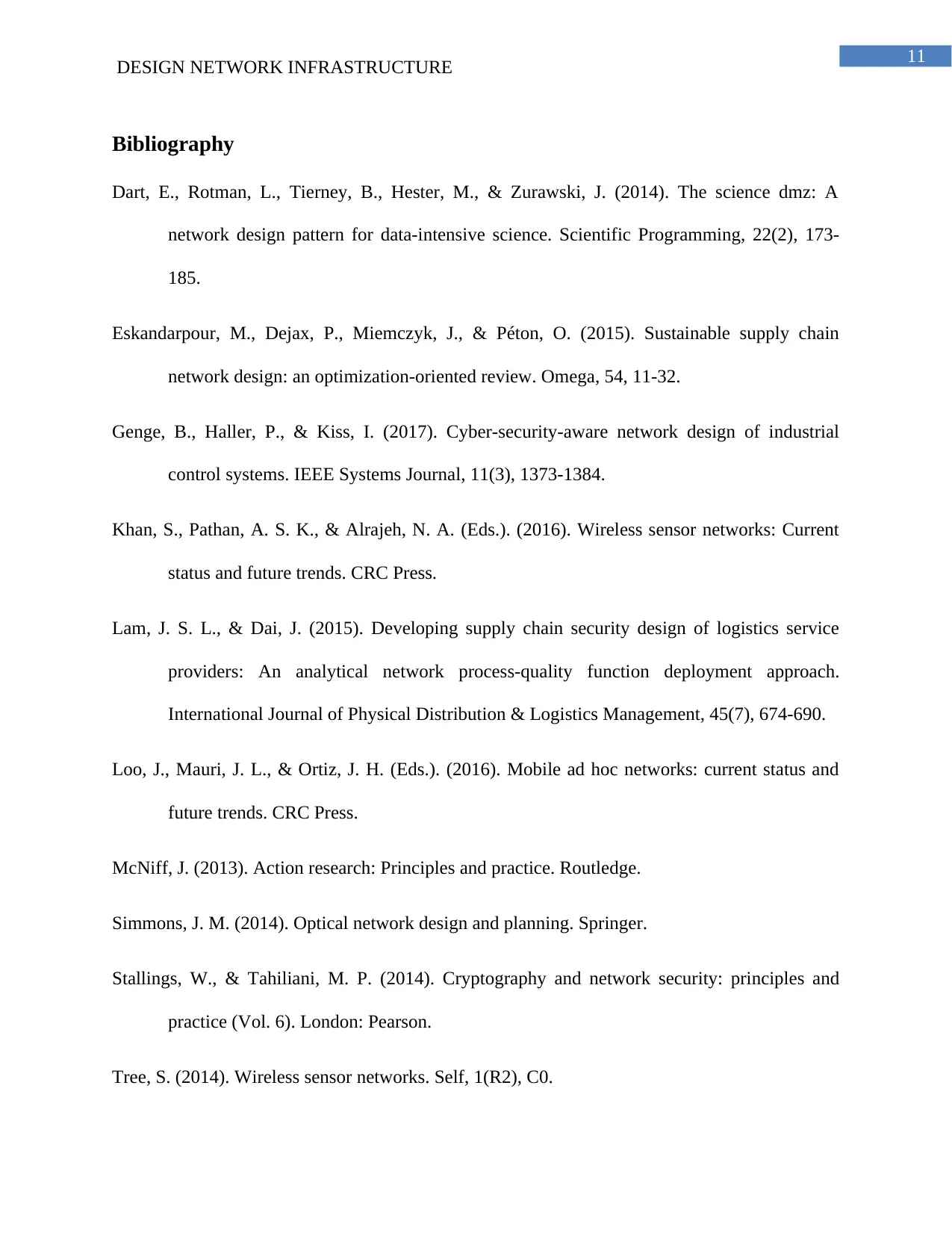
11
DESIGN NETWORK INFRASTRUCTURE
Bibliography
Dart, E., Rotman, L., Tierney, B., Hester, M., & Zurawski, J. (2014). The science dmz: A
network design pattern for data-intensive science. Scientific Programming, 22(2), 173-
185.
Eskandarpour, M., Dejax, P., Miemczyk, J., & Péton, O. (2015). Sustainable supply chain
network design: an optimization-oriented review. Omega, 54, 11-32.
Genge, B., Haller, P., & Kiss, I. (2017). Cyber-security-aware network design of industrial
control systems. IEEE Systems Journal, 11(3), 1373-1384.
Khan, S., Pathan, A. S. K., & Alrajeh, N. A. (Eds.). (2016). Wireless sensor networks: Current
status and future trends. CRC Press.
Lam, J. S. L., & Dai, J. (2015). Developing supply chain security design of logistics service
providers: An analytical network process-quality function deployment approach.
International Journal of Physical Distribution & Logistics Management, 45(7), 674-690.
Loo, J., Mauri, J. L., & Ortiz, J. H. (Eds.). (2016). Mobile ad hoc networks: current status and
future trends. CRC Press.
McNiff, J. (2013). Action research: Principles and practice. Routledge.
Simmons, J. M. (2014). Optical network design and planning. Springer.
Stallings, W., & Tahiliani, M. P. (2014). Cryptography and network security: principles and
practice (Vol. 6). London: Pearson.
Tree, S. (2014). Wireless sensor networks. Self, 1(R2), C0.
DESIGN NETWORK INFRASTRUCTURE
Bibliography
Dart, E., Rotman, L., Tierney, B., Hester, M., & Zurawski, J. (2014). The science dmz: A
network design pattern for data-intensive science. Scientific Programming, 22(2), 173-
185.
Eskandarpour, M., Dejax, P., Miemczyk, J., & Péton, O. (2015). Sustainable supply chain
network design: an optimization-oriented review. Omega, 54, 11-32.
Genge, B., Haller, P., & Kiss, I. (2017). Cyber-security-aware network design of industrial
control systems. IEEE Systems Journal, 11(3), 1373-1384.
Khan, S., Pathan, A. S. K., & Alrajeh, N. A. (Eds.). (2016). Wireless sensor networks: Current
status and future trends. CRC Press.
Lam, J. S. L., & Dai, J. (2015). Developing supply chain security design of logistics service
providers: An analytical network process-quality function deployment approach.
International Journal of Physical Distribution & Logistics Management, 45(7), 674-690.
Loo, J., Mauri, J. L., & Ortiz, J. H. (Eds.). (2016). Mobile ad hoc networks: current status and
future trends. CRC Press.
McNiff, J. (2013). Action research: Principles and practice. Routledge.
Simmons, J. M. (2014). Optical network design and planning. Springer.
Stallings, W., & Tahiliani, M. P. (2014). Cryptography and network security: principles and
practice (Vol. 6). London: Pearson.
Tree, S. (2014). Wireless sensor networks. Self, 1(R2), C0.
1 out of 12
Related Documents
Your All-in-One AI-Powered Toolkit for Academic Success.
+13062052269
info@desklib.com
Available 24*7 on WhatsApp / Email
![[object Object]](/_next/static/media/star-bottom.7253800d.svg)
Unlock your academic potential
© 2024 | Zucol Services PVT LTD | All rights reserved.





